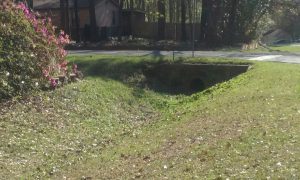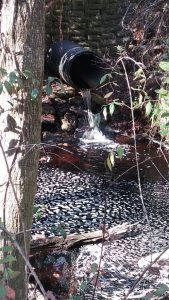Stormwater runoff is water from rainfall that flows along the land surface. This runoff usually finds its way into the nearest ditch or water body, such as a river, stream, lake or pond. Generally speaking, in natural undeveloped areas only 10% of rainfall is runoff. About 40% returns to the atmosphere though evapotranspiration, which is the water evaporated from land and plant surfaces plus water lost directly from plants to the atmosphere through their leaves. The remaining 50% of rainfall soaks into the ground, supporting vegetation, contributing to streamflow and replenishing groundwater resources. In Florida, where 90% of the population relies on groundwater for their drinking water, aquifer recharge from infiltrating rainwater is vital.
As landscapes become more developed, areas that use to absorb rainwater are replaced by impervious surfaces like rooftops, driveways, parking lots and roads. Additionally, we are levelling our land, removing natural depressions in the landscape that trap rainwater and give it time to seep back into the ground. As a result, a higher percentage of rainfall is becoming runoff and which flow at faster rates into storm drainages and nearby water bodies instead of soaking into the soil.
A major problem with stormwater runoff is that as it flows over surfaces, it picks up potential pollutants that end up in our waterways. These include trash, sediment, fertilizer and pesticides from lawns, bacteria from dog waste, metals from rooftops, and oil from parking lots and roads. Stormwater runoff is often the main cause of surface water pollution in urban areas.
Luckily, there are ways in which we can all help slow the flow and reduce stormwater runoff. These reductions can give rainfall more time to soak back into the ground and replenish our needed stores of groundwater.
What can you do to help “slow the flow” of stormwater?
The UF/IFAS Florida Friendly Landscaping Program provides the following recommendations that you, as a homeowner, can do to reduce stormwater runoff from your property:
- Direct your downspouts and gutters to drain onto the lawn, plant beds, or containment areas, so that rain soaks into the soil instead of running off the yard.
- Use mulch, bricks, flagstone, gravel, or other porous surfaces for walkways, patios, and drives.
- Reduce soil erosion by planting groundcovers on exposed soil such as under trees or on steep slopes
- Collect and store runoff from your roof in a rain barrel or cistern.
- Create swales (low areas), rain gardens or terracing on your property to catch, hold, and filter stormwater.
- Pick up after your pets.
- Clean up oil spills and leaks on the driveway. Instead of using soap and water, spread cat litter over oil, sweep it up and then throw away in the trash.
- Sweep grass clippings, fertilizer, and soil from driveways and streets back onto the lawn. Remove trash from street gutters before it washes into storm drains. The City of Tallahassee’s TAPP (Think About Personal Pollution) Campaign is another excellent resource for ways in which you can help reduce stormwater runoff (http://www.tappwater.org/).
- For more information on stormwater management on your property and other Florida Friendly Landscaping principles, you can visit the Florida Friendly Landscaping website at: https://ffl.ifas.ufl.edu.
TAPP also provides a manual for homeowners on how to build a raingarden, which can be found at http://tappwaterapp.com/what-can-i-do/build-a-rain-garden/. Raingardens are small depressions (either naturally occurring or created) that are planted with native plants. They are designed to temporarily catch rainwater, giving it time to slowly soak back into the ground.

Grass covered drainage ditches slow the flow of stormwater runoff and allow more rainwater to soak back into the ground.
Photo: Andrea Albertin
- What to Do if a Sinkhole Opens on Your Property? - June 6, 2025
- Workshop on Private Well and Septic System Basics - October 18, 2024
- Septic system maintenance after a flood - June 7, 2024

